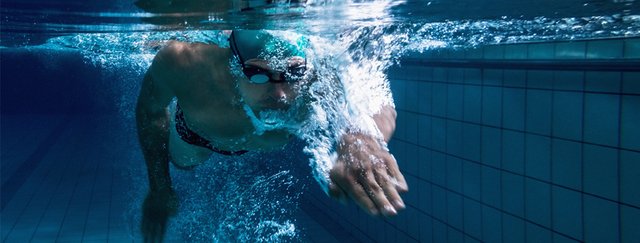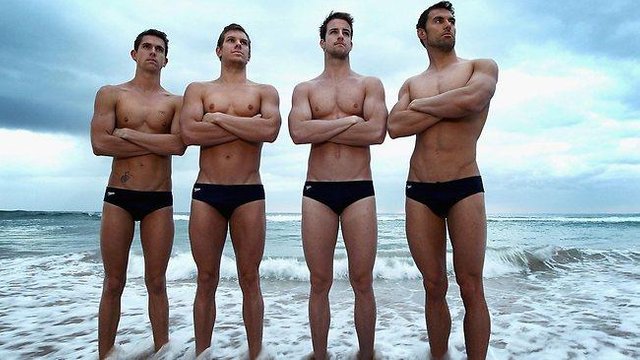15 BEHAVIOR HAVE YOU ONLY MEET IN SWIMMERS
They are among us. Breathe so much that all cars, like everyone else, but only on land, prefer to spend time in the water. Swimmers. Prudent people, squeezing their efforts, dedicating themselves to self-improvement, character and valuable skill, are patient. Then you know the swimmer?
1. Favorite smell is chlorine
The swimmers are in the water for several hours a day. No wonder their skin and hair are soaked with this scent. For the rest of the day "sitting" all over the body. Maybe for many people it is not the most pleasant smell, but for the watery people will always remain on the top - finally the morning entrance to the basin and taking air with this aroma stimulates us better than strong coffee and reminds us why we train.
2. The hair resembles hay
Among swimmers this phenomenon is rather absent, because most of them use the workouts with caps (for convenience and hair care). Gentlemen, from my observation, rather prefer to swim without a cap on the training. I do so for the sake of trivial reason - during the workout the body produces a lot of energy, and the water perfectly cools the overheated head. The side effect is the hair, which at first glance may look like a person who had close contact with the electricity - frayed, each in the other. Well, they generally live their own lives. The touches are terribly harsh, certainly damaged by the action of chlorinated water and they bounce into larger bands - haystacks are a perfect comparison. However, it gives a unique style, especially visible at the competition, when the players have just arrived and when they go to the swimming pool take off their caps, revealing thunderstorms. Often after the morning training, when I go to work, my friends ask me if I'm going to make up my hair. On the modeling and combing tools I can save - chlorine does its job. The hairdresser's visit begins with a gloved hairstyle, and splashing with water immediately activates chlorine. And it has its charm ...
3. Shower your favorite place by the pool
Of course, when there is warm water in it. It is not always possible to count on such prosperity. The shower is occupied by the swimmers after training for even a dozen minutes, in the end the water is always cold, and the fatty tissue of the athlete - as a remedy. In addition, at home rarely use it.
4. Shaving ritual before the competition
Everyone has their time - some get up early in the morning on the day of the competition, others shave their body late in the evening on the eve of the start. This applies, of course, to women, but also (and perhaps above all) to men. Many people who do not deal with the sport every day are wondering why: "The cyclists to be more aerodynamic, and swimmers - more streamlined?" In fact, it is worthwhile to rectify - the riders shave their legs so that the ointments during the massage better absorbed, and the wounds caused by falls and collisions are better to heal. Floaters actually get rid of their hairiness not so much to increase their hydrodynamics, which improves the feeling of water. Everything by skin irritating shaving and abrasion of the top layer of the epidermis. It is also because of this, the players, already on the starting platform, patted their body and scratched. This will increase the blood supply and thus improve the sensation of the water.
5. Feel the water
Imagine you are just entering the pool water. What is the? Cold, warm, clear or slightly more turbid? Any other terms? No? And a swimmer after swimming a dozen or so meters in a new facility can tell if the pool is fast or slow. The effect has several factors - temperature, and hence the density, amount and type of chemicals used for water treatment, hardness, as well as the depth of water and the material used in the pool construction. Of course this is a subjective feeling, but it is certainly better to swim in the colder water than in the so-called. Soup when we feel that the water escapes us through the fingers and does not provide an adequate flow rate (moreover, it is more difficult to cool the overheated body and the oxygen exchange is worse).
6. They are accompanied by eternal fatigue
Swimming is a sport that requires a lot of time spent in training. The standard is about 10-11 training sessions per week in water, which gives you two workouts per day. This is also the so-called. exercises on land, ie elements of work on flexibility, strength or reflex, as well as gym. It takes a lot of dedication - often at six in the morning we are already in the water. And yet you have to dress and pack before, eat breakfast and get to workout. Many of us are just getting out of bed when the training group is approaching the end of their morning session. In the afternoon there is another training session. In the meantime, it is time for school or work. It's hard for proper regeneration. That is why we love to sleep when possible. It is also worth to remember a sentence: "No matter how hard you train, there will always be someone who is training harder than you." Olympic champion in the 100 m classic style of Rio de Janeiro, British Adam Peaty, his first training (lasting up to 5 hours!) Starts at four in the morning. Space, but in this way "steel hardens".
7. Absorb a lot of food
There was no machine that would do the job without supplying energy. It would certainly be a perpetuum mobile. A healthy, adult and normally working man should maintain at least 3000 calories a day to maintain his weight. Swimmers can only burn as much during the two training sessions in one day. Awake by physical activity, the human machine still has more appetite for it. There is also the issue of warming the body in water and the need for the growth of the body (especially in adolescence). It gives us a really solid calorie score. Although it is true that the quality of the fuel (in this case of food) has a huge impact on the functioning of the body, it is undeniable fact that in our environment you will find a whole lot of fans of a cream of chocolate and walnut Italian production. At the end of the curiosity - at one point in his life Michael Phelps ate at least 12,000. calories a day! As he once gave the New York Times, the Olympic multimedia player began his day with three fried egg sandwiches with cheese, lettuce, tomatoes, onion and mayonnaise, five egg omelet, porridge, three French toasts with icing sugar, three chocolate pancakes and two cups coffee. Lunch is followed by two sandwiches with ham, cheese and mayonnaise and a half-kilogram bowl of pasta. Dinner is again the same portion of pasta and large pizza. In the meantime everything is supplemented with isotonic drinks and protein supplements. For me personally a portion for three days.
8. appreciate the time
The lifestyle of the swimmers is not the most pleasant. Weekend is a well-deserved reward after a hard week - they have time for themselves and their loved ones. In training, in turn, to hear from the coach between the tasks of the word "minute break" is nothing to hit a triple in Lotto - it is not enough that only so much, but always better than nothing. The swimmer also knows how much, and at the same time little to lose by one hundredth of a second. For nearly a decade I can not leave the thought of losing 0.09 seconds to the national team. That is why we learn to lose, clench our teeth and every morning as dawn leaps into the icy water to be faster and faster.
9. Wear swimming clothes
Training, competitions or normal free days - you will most likely see a swimmer in clothing branded with one of several swimwear manufacturers. In addition, swimmers have tons of t-shirts of all kinds. For several years, there has also been a trend in the pools to color some everyday effort. Most of the players appear in training in multicolored, eye-catching outfits. They also have several pairs of swimming goggles and some caps. The problem is also buying clothes in stores. Then some of us realize that it is a bit undersized and hard to buy something that fits perfectly. I sometimes had trouble buying a jacket when, despite the ideal width in the shoulders, sleeves suddenly appeared too short.
10. Avoid swimming pool at leisure
Try to arrange a swimmer for the pool. 90% will refuse. Because in the end how much can you swim? But when he agrees, he certainly will not be a companion to the conversation - he will get bored too quickly and will move forward.
11. They are masters of concentration
Although it is impossible to make such an impression on a daily basis, looking at the disheveled hair and tired faces and sleeping dreams, during the competition they turn into silent warriors. Everybody before the start has a way to mobilize - some are looking for a conversation waiting for the release card, others try to focus on solitude, silence visualizing the upcoming race, others in turn on the earphones, dressed in several layers of warm clothes, they warm up energetically. Everything to stand on the post, be aware of the well done work and after waiting for the fans waiting for the stands waiting for the electronic signal of referee-starter.
12. They have their ways of coaching
Tiredness and the often creepy boredom resulting from the monotony of swimming from wall to wall forces athletes to be creative. - although with my observation, it is more about age and awareness, why we really train. There are many ways to reduce the amount of time spent on training. I teach younger athletes that cheating on training is really a shame not for the coach, but for the athlete himself - perhaps honest performance of tasks will make you pass someone for a fraction of a second. Examples can be exchanged a lot, among others. Extend warm-up on land (and talk to others) to get in at the latest; shearing, that is, shortening the distance by not leaning to the recurrent wall; delaying the start of consecutive repetitions in the task (eg by skipping the arrow of the given color on the pool clock); pulling on the rope while swimming with the back; pretending pain in shoulders or abdomen; correcting the eyeglasses that suddenly started coming from here rather than evaporating; and much, much more.
13. Sport not quite individual
While swimming you really do not have to talk to anyone and you talk in your head with yourself (during long tasks, some of you repeat this way eg material for classes - I like to "quietly" sing), it is appreciated very role players from the team. It is extremely important to be able to get along with each other. Race on parallel tracks during training tasks, which translates into disposition during the competition. It is important that your club mate is also a motivator when you no longer want and you do not have the strength (and vice versa). Also, when you do not want to get out of bed a few minutes after five in the morning, you know that others also get up for training: competitors, trainer, but also somewhere else your rival you want to beat in the upcoming struggles. And there is nothing more effective in swimming than relay races, huge emotion that frees the players and the stands when the fight lasts to the last meters. Below the film from the 4 × 100 m freestyle relay from the 2008 Beijing Olympics. Crazy French fight with the Americans. See for yourself what happens at the last relay change. For me, this video is the essence of swimming and a huge motivator, and every time you watch it shakes the whole body.
14. They love training on outdoor pools
Such swimming pools, although they are unfortunately rare in Poland, have the same advantages. Training sessions are held in the summer when the temperature of the environment is no longer threatened. Beautiful is the fog hovering over the pool early in the morning, the sunrise seen from the surface of the water, and in the afternoon its west. And there's another vitamin D injection coming out of the sun-working skin that improves the mood. Great and even body tan (except for the areas covered by the training attire and glasses), as well as the lightening of the hair. Well, something that happens sometimes in training camps and what the riders are waiting for - a thunderstorm that forces you out of the water.
15. Love the forgiveness
The training cycle consists of building the oxygen base, strength, and then entering the BPS phase (Direct Start Preparation) about 1.5 months before the competition. It's really powerful and finishing season riders. All are then waiting for the arrival of the last days before the competition, or tapering. The training distance is drastically reduced, with a lot of emphasis placed on the technical and speed elements that are important in the race itself. Same intervals between tasks are much longer, so the players can rest enough.
Did you recognize yourself in any of the subsections? Or maybe you are swimming and you notice other, unspecified, typical float behavior? Let me know in the comment!




Welcome to Steem Community @snoopcane! As a gentle reminder, please keep your master password safe. The best practise is to use your private posting key to login to Steemit when posting; and the private active key for wallet related transactions.
In the New Steemians project, we help new members of steem by education and resteeeming their articles. Get your articles resteemed too for maximum exposure. You can learn more about it here: https://steemit.com/introduceyourself/@gaman/new-steemians-project-launch
Nice to meet you, @snoopcane! Welcome to the Steemit Community, wish you good luck and a good start, ive send you a small tip and followed you, hope you have an amazing day! :)
great to hear that, thank you! :)
nice post thanks... :D
Nice post kindly upvote and follow back @seybam